Pearl Grading - The Comprehensive Buyer's Guide
-1140x300w.jpg)
Natural Pearls, the emblem of sophistication and luxury, come in various sizes, shapes, styles, hues, and prices. One must be aware of specific quality grades when purchasing gem-quality pearls because most individuals are not specialists at determining the pearl's quality.
It is essential to understand pearl grading to buy gem-grade pearls at the greatest prices. Before making your final pearl jewelry purchase, it's important to understand pearl grading systems. Unfortunately, the pearl industry hasn't established a universal grading system, unlike other gems like diamonds, with a standard grading system that allows uniformity in the consumer market. Customers must buy from reliable and trustworthy pearl suppliers who uphold the highest standards for quality.
Why Pearl Grading?

Before really buying pearl jewelry, it's important to understand pearl grading. It is challenging to judge the quality of pearls as ordinary people. Despite round pearls and near-round pearls being quite similar, the price difference is so considerable that grading is required in this instance as a guide to help consumers make better choices.
As there isn't a universally accepted set of norms to grade pearls, even the accepted scales can appear misleading. Since criteria differ from seller to seller, farmer to farmer, and auction to auction, they are truly inconsistent. This occasionally leads to perplexed clients who find comparing pearl jewelry on different websites challenging.
Pearl Grading System
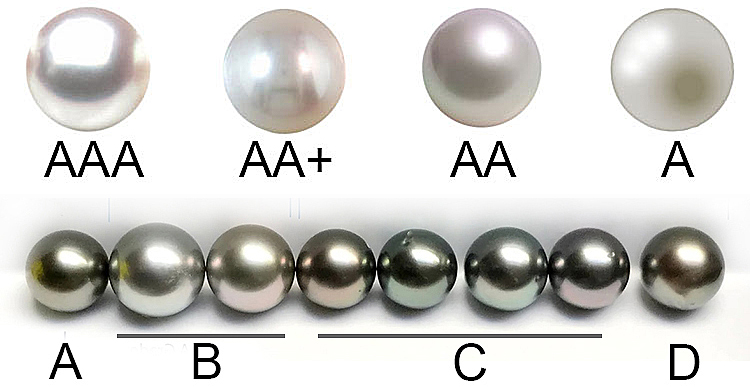
When it comes to pearl grading, what seems like an infinite number of criteria for grading methods are utilized globally. Unfortunately, there is no standardized grading system, as was previously stated.
The most popular pearl grading schemes are the following:
· Japanese Grading (Mikimoto Grading): In addition to the unique grades of Tennyo and Hanadama, the Japanese Standard Grading system also employs an A-AAA system. Mikimoto, an idol in the pearl industry, was the one who first developed this approach. Tennyo and Hanadama grades in the Japanese Grading System demand a nacre thickness of at least 0.4 mm.
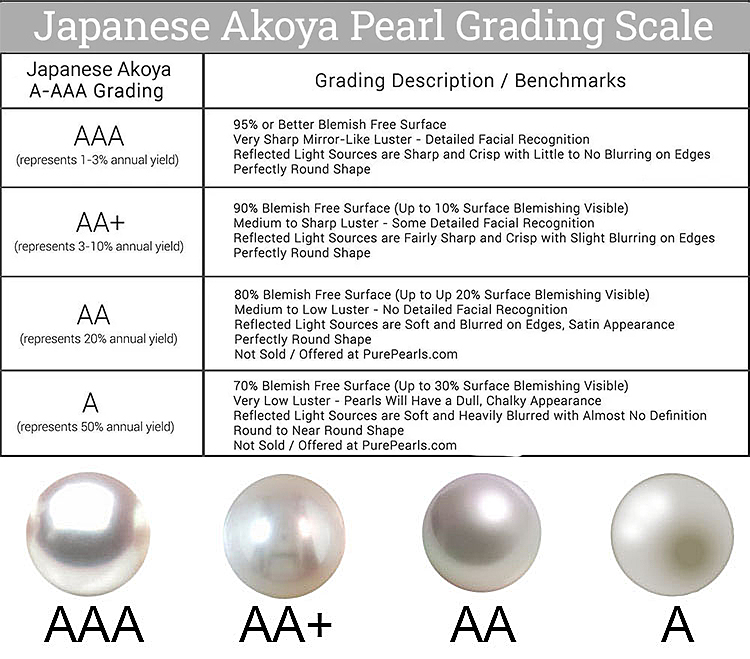
· Tahitian Grading System: To control the quality and reputation of the Tahitian Black Pearl, the Tahitian government originally instituted the Tahitian Standard Grading System. The main reason is to ensure proper nacre thickness and overall pearl quality.
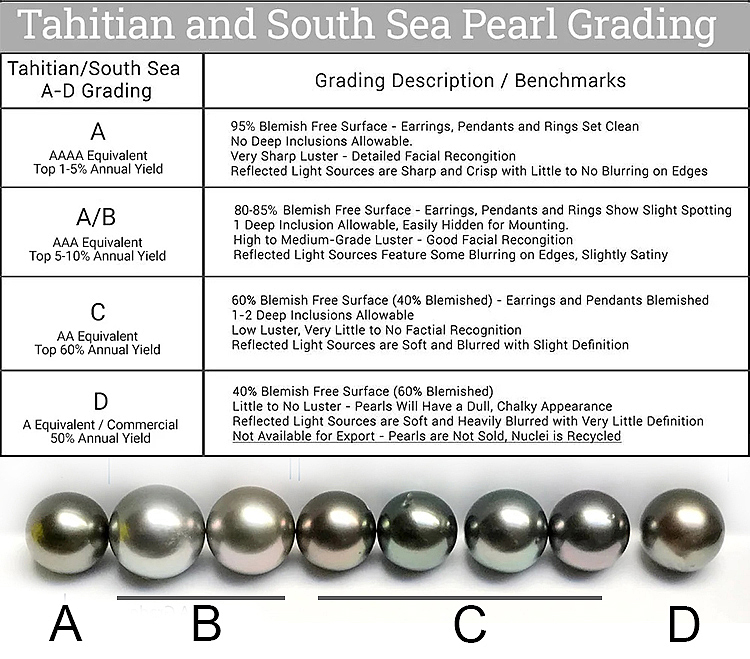
· Kyllonen Grading System: The Kyllonen grading system was created to eliminate any uncertainty in the pearl grading industry. Kyllonen divides grading into strands and loose pearls. Individual beauty is rated for loose pearls, while overall beauty and matching are graded for strands.
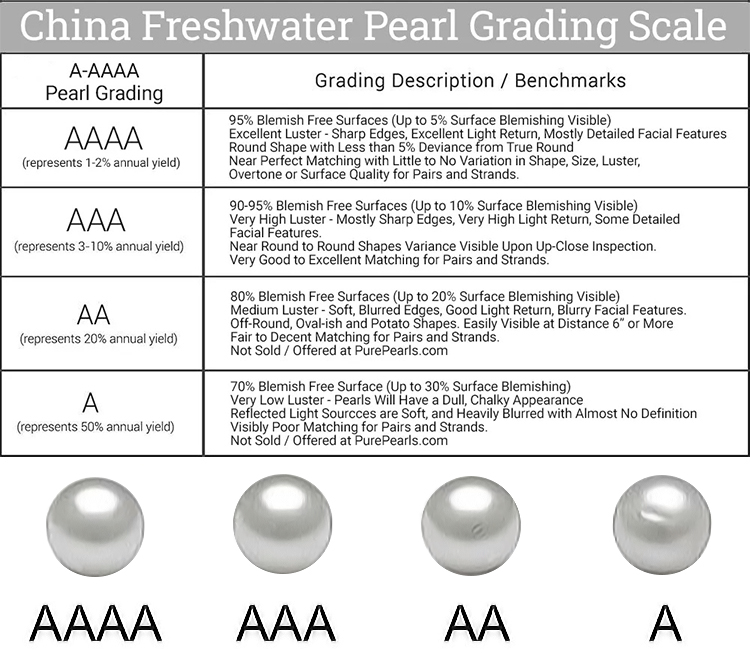
· Chinese Grading System: The Chinese Standard Grading System is one of Pearl's most unclear grading systems. This results from the absence of a dominant market player or governmental body that would standardize the grading system.

What Are The Major Pearl Grading Scales?
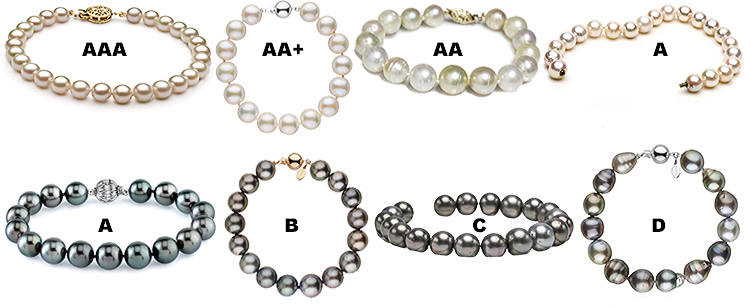
Pearl grading attempts to uphold strict quality controls to attain quality and confidence. Pearl graders can tell the difference between high-quality pearls and low-quality pearls by following a set of rules. Even if it takes a long time and is difficult, the procedure is well worth it. The pearl business recognizes the use of two different grading systems. The Tahitian system, also referred to as the A-D system, is one; the AAA-A system is the other. The AAA-A is the highest quality of pearls known and is valuable compared to A-D.
All varieties of pearls can be tested with the AAA-A method; however, freshwater pearls and Akoya pearls are the most popular. The A-D System is only used for the evaluation of Tahitian pearls and South Sea pearls.
The A-D System, or Tahitian System
A is the highest grade in this system, and D is the lowest. The AAA-A system is occasionally used in place of the A-D system, based on a French Polynesian government standard.
· A: Extremely high Luster, with flaws covering less than 10% of the surface.
· B: High to medium Luster and flaws on less than 30% of the surface.
· C: Medium Luster and flaws on less than 60% of the surface.
· D: The lowest grade doesn't consider the Luster, only surface flaws.
The "AAA-A" Scale
The pearls are graded using a scale of AAA to A, with AAA pearls being the highest.
· AAA: Almost flawless Pearls have a flash of high brilliance and have a surface that is 95% free of flaws.
· AA: High Luster and a surface that is 75% defect-free
· A: A surface with more than 25% flaws and a lower luster.
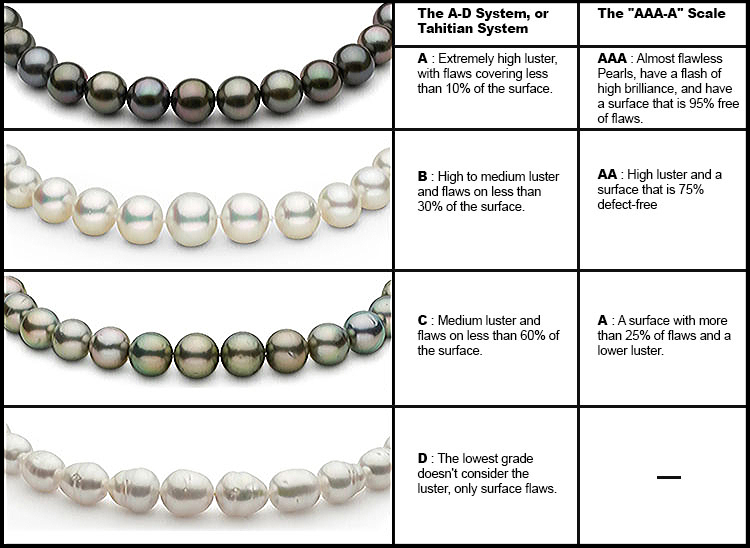
How Do The Grading Systems Work?
Even though both rating systems utilize different overall grades to evaluate pearls, they both focus on some of the same qualities that define a pearl's quality. Pearls are graded and valued according to the following seven value factors:
Luster:

A pearl's Luster measures how dazzling and bright it appears. Objects that are sharply reflected on a pearl's surface are referred to as "luster" by jewelers. A pearl with poor shine is nothing more than a chalky bead. The glow that emanates from a pearl's interior and is caused by light passing through its layers of nacre and reflecting at the observer is best described as Luster. The uniformity and smoothness of the nacre layers directly influence the pearl's brilliance.
Surface clarity:

The next most crucial Value Factor, surface quality, measures how clean, smooth, free from blemishes, and flawless a pearl can appear. A certain amount of surface flaws will be noticeable to almost all pearl buyers. The two most important aspects of surface quality flaws are how obvious they are and if they significantly impact the pearl's durability.
Blemishes (inclusions) can be:
· Abrasions: Scuffs or scrapes that lessen a pearl's Luster or color
· Minor color changes occur as spots.
· Bumpy-small bubbles on the surface
· Rough spots on the nacre are called wrinkles.
Chips and gaps are typically serious surface quality flaws that will reduce the value of even the most beautiful pearls.
Nacre thickness and quality:

As the base upon which all other attributes rest, nacre thickness is arguably the most significant Value Factor for pearls. A pearl without rich, evenly nacre quality will not appear as lovely and will not endure as long.
Typically averaging 2-4mm thick around the bead nucleus inside, Tahitian pearls and South Sea pearls have extraordinarily thick nacre.
Color:

There is a wide variety of colors in both natural and manufactured pearls. Warm colors like yellow, orange, and pink coexist with cold colors like blue, green, and violet. From light to dark, pearls come in a wide range of tones. Pearl colors typically have a smooth, gentle character and are muted. The most popular pearl colors are often white and grey-white, though individual preferences may dictate differently.
A pearl's price will rise if it has a particular overtone since it is more expensive and rarer than another. As an illustration, South Sea pearls with the color Golden in 22K are much more expensive than those with Golden in 14K. Because they are more uncommon than pearls with silver overtones, white South Sea pearls with a beautiful rose overtone will cost more.
Size:

When all other aspects of value are equal, larger pearls of the same type are rarer and more precious. From tiny 1.0mm seed pearls up to 21.0mm, and infrequently even larger, cultured pearls can vary in Size. The stunning 29.65mm South Sea baroque pearls are the world's largest cultured pearl of all the pearls.
Like diamonds, Size can cause costs to rise rapidly with each additional millimeter. This is so because bigger pearls are considerably more challenging to grow, take much longer to produce, and are much rarer.
Shape:

The most difficult Shape to produce, the round is also the rarest and, usually speaking, the most expensive Shape of a cultured pearl. These pearl shapes are the most common and are what practically all pearl shoppers picture when they envision a traditional pearl necklace.
The most popular shapes after perfectly round pearls are smooth drops, buttons, and Baroques. The pearl's evenly symmetrical shapes are the most crucial factor since they are more aesthetically beautiful and practical for usage in most types of pearl jewelry.
Matching:

This characteristic relates to a certain method of pearl stringing that produces the most uniform arrangement of pearls in terms of Shape, color, Luster, spotting, and graduation. The level of matching describes how well pearl necklaces, bracelets, earrings, and sets coordinate. Considerations for pearl matching include:
· Size
· Shape
· Surface Quality
· Luster
· Body Color
· Overtone
The mixed colors do not affect the pearl value as long as the pearl strands have a pleasing overall tone and aesthetic.
Conclusion

To be able to compare grades and grading methods from one company to another is likely impossible. This is perhaps the most crucial concept to grasp while learning about Pearl Grading to make a sound buying decision. However, even if you aren't an expert in checking pearl types, the pearl grading system can help you determine the worth of the finest quality pearls.
A pearl is a unique, natural gem formed inside a mollusk that is still alive. Each pearl's origins, qualities, and treatments might be very different. In conclusion of all the above information, we can say that buying the highest quality pearls can be very challenging without a thorough and consistent grading process.


Leave a Comment